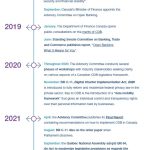In recent
years, there has been a global drive toward financial inclusion for underbanked
groups. The idea is to give these groups access to fundamental financial
services like savings accounts, loans, and insurance.
However, there
is growing fear that this effort for inclusion could result in predatory
activities that would harm the very groups it seeks to assist.
Predatory
inclusion refers to the practice of providing financial services to underbanked
populations in a way that ultimately damages them. This can occur through a
variety of means, including high-interest loans, hidden fees, and aggressive
debt collection activities.
Predatory
inclusion can also arise when financial service providers take advantage of
underbanked communities’ lack of financial knowledge, resulting in a cycle of
debt and financial instability.
The
Consequences of Predatory Inclusion
There are a
number of dangers involved with predatory inclusion. The first risk is that it
will create a debt cycle for underbanked populations. High-interest loans and
hidden fees can quickly build up, making it difficult for borrowers to make
payments. This can result in a difficult-to-break debt cycle.
Another risk of
predatory inclusion is that it can impair underbanked communities’ credit
scores. Late or missed payments can lower credit scores, making it more
difficult for debtors to get credit in the future. This might result in a
vicious cycle of debt and financial insecurity.
Finally,
predatory inclusion can undermine trust in financial service providers. If
underbanked people believe they are being exploited, they may be less likely to
use financial services in the future. This might result in a lack of financial
inclusion and the persistence of the poverty cycle.
The Value of
Financial Literacy
Financial
literacy is one method of combating predatory inclusion. People who are
underbanked may lack the knowledge and skills needed to make sound financial
decisions. Financial service providers can empower underbanked populations to
make educated financial decisions by providing financial education and
resources.
Workshops,
internet tools, and one-on-one counseling are all examples of financial
education. Financial service companies can also collaborate with community
organizations to help underbanked people with financial education and
resources.
Oversight
and Regulation
Regulation and
monitoring are another means of combating exploitative inclusion. Financial
service providers must be held accountable for their operations and must
operate in a transparent and ethical manner. This can be accomplished by
government control and oversight, as well as through industry self-regulation.
Financial
service providers should also be compelled to clearly and transparently
disclose all fees and charges related to their services. This can assist in
avoiding hidden fees and other exploitative activities.
Furthermore,
financial service providers should be obligated to offer clear and simple
information regarding the terms and circumstances of their loans to borrowers.
This can assist to avoid misunderstandings and ensure that borrowers are fully
informed about the dangers and rewards of borrowing money.
Innovation
and Technology
Finally,
technology and innovation can help to counteract predatory inclusion.
Blockchain and mobile payments, for example, can give underbanked communities more transparent and efficient access to financial services.
For example,
blockchain technology can be used to establish a more secure and transparent
system for tracking financial transactions. Mobile payments can give
underbanked people access to fundamental financial services like savings
accounts and money transfers via their mobile phones.
How to Actively Fight against Predatory Inclusion
Predatory
inclusion can lead to financial harm, perpetuate inequality, and hinder
economic growth. As such, it becomes quintessential to fight against predatory
inclusion in underserved and unbanked populations. We’ve highlighted ways of
effectively doing it.
Increase Financial Literacy and Education
One of the most
effective ways to fight against predatory inclusion is to increase financial
literacy and education in underserved and unbanked populations. This includes
teaching people about the different types of financial products and services
available to them, how to manage their money effectively, and how to avoid
scams and other fraudulent practices. This can be achieved through community
programs, educational workshops, and partnerships with financial institutions.
Advocate for Fair Lending Practices
Another way to
fight against predatory inclusion is to advocate for fair lending practices.
This includes promoting transparency in lending, advocating for responsible
lending practices, and fighting against discriminatory lending practices.
Advocacy groups can work to ensure that lenders are held accountable for their
lending practices and that they are not taking advantage of vulnerable
populations.
Promote Access to Affordable Financial
Products and Services
Access to
affordable financial products and services is crucial for underserved and
unbanked populations. Financial institutions can work to create products and
services that meet the unique needs of these populations and that are affordable
and transparent. This can include things like low-interest loans, savings
accounts with no fees, and easy-to-understand financial statements.
Foster Partnerships between Financial
Institutions and Community Organizations
Partnerships
between financial institutions and community organizations can help to promote
financial inclusion and fight against predatory practices. These partnerships
can help to increase access to financial products and services, promote
financial literacy and education, and build trust between financial
institutions and underserved communities.
Support Regulation and Enforcement
Finally,
supporting regulation and enforcement is critical for fighting against
predatory inclusion. This includes advocating for policies that protect
consumers from predatory practices and ensuring that financial institutions are
held accountable for their actions. Government agencies can work to enforce
these regulations and hold financial institutions accountable for any predatory
practices.
Conclusion
Financial
inclusion is a vital goal, but it must be achieved without harming underbanked
populations. Predatory inclusion can result in a vicious cycle of debt and
financial insecurity, as well as a loss of trust in financial service
providers.
Financial
service providers must focus on financial literacy, regulation and oversight, and
innovation and technology to combat predatory inclusion. By doing so, they may
serve underbanked populations with transparent, ethical, and empowering
financial services.
Financial
knowledge is a critical component in the fight against predatory inclusion.
Financial service providers may empower underbanked communities to make
informed financial decisions by educating them on financial literacy.
Understanding the risks and rewards of financial goods, budgeting and saving,
and debt management are all part of this.
Regulation and
monitoring are also critical in the fight against predatory inclusion.
Financial service providers must be held accountable for their actions, and
regulators must guarantee that they are transparent and ethical.
This includes
requiring businesses to declare in a clear and open manner all fees and charges
related to their services, as well as providing borrowers with plain and
easy-to-understand information regarding the terms and circumstances of their
loans.
In addition,
innovation and technology can play an important role in combatting predatory
inclusion. Blockchain and mobile payments, for example, can give underbanked
people more secure and efficient access to financial services. Using these
technologies, financial service providers can provide underbanked people with
more transparent and empowering financial services.
In recent
years, there has been a global drive toward financial inclusion for underbanked
groups. The idea is to give these groups access to fundamental financial
services like savings accounts, loans, and insurance.
However, there
is growing fear that this effort for inclusion could result in predatory
activities that would harm the very groups it seeks to assist.
Predatory
inclusion refers to the practice of providing financial services to underbanked
populations in a way that ultimately damages them. This can occur through a
variety of means, including high-interest loans, hidden fees, and aggressive
debt collection activities.
Predatory
inclusion can also arise when financial service providers take advantage of
underbanked communities’ lack of financial knowledge, resulting in a cycle of
debt and financial instability.
The
Consequences of Predatory Inclusion
There are a
number of dangers involved with predatory inclusion. The first risk is that it
will create a debt cycle for underbanked populations. High-interest loans and
hidden fees can quickly build up, making it difficult for borrowers to make
payments. This can result in a difficult-to-break debt cycle.
Another risk of
predatory inclusion is that it can impair underbanked communities’ credit
scores. Late or missed payments can lower credit scores, making it more
difficult for debtors to get credit in the future. This might result in a
vicious cycle of debt and financial insecurity.
Finally,
predatory inclusion can undermine trust in financial service providers. If
underbanked people believe they are being exploited, they may be less likely to
use financial services in the future. This might result in a lack of financial
inclusion and the persistence of the poverty cycle.
The Value of
Financial Literacy
Financial
literacy is one method of combating predatory inclusion. People who are
underbanked may lack the knowledge and skills needed to make sound financial
decisions. Financial service providers can empower underbanked populations to
make educated financial decisions by providing financial education and
resources.
Workshops,
internet tools, and one-on-one counseling are all examples of financial
education. Financial service companies can also collaborate with community
organizations to help underbanked people with financial education and
resources.
Oversight
and Regulation
Regulation and
monitoring are another means of combating exploitative inclusion. Financial
service providers must be held accountable for their operations and must
operate in a transparent and ethical manner. This can be accomplished by
government control and oversight, as well as through industry self-regulation.
Financial
service providers should also be compelled to clearly and transparently
disclose all fees and charges related to their services. This can assist in
avoiding hidden fees and other exploitative activities.
Furthermore,
financial service providers should be obligated to offer clear and simple
information regarding the terms and circumstances of their loans to borrowers.
This can assist to avoid misunderstandings and ensure that borrowers are fully
informed about the dangers and rewards of borrowing money.
Innovation
and Technology
Finally,
technology and innovation can help to counteract predatory inclusion.
Blockchain and mobile payments, for example, can give underbanked communities more transparent and efficient access to financial services.
For example,
blockchain technology can be used to establish a more secure and transparent
system for tracking financial transactions. Mobile payments can give
underbanked people access to fundamental financial services like savings
accounts and money transfers via their mobile phones.
How to Actively Fight against Predatory Inclusion
Predatory
inclusion can lead to financial harm, perpetuate inequality, and hinder
economic growth. As such, it becomes quintessential to fight against predatory
inclusion in underserved and unbanked populations. We’ve highlighted ways of
effectively doing it.
Increase Financial Literacy and Education
One of the most
effective ways to fight against predatory inclusion is to increase financial
literacy and education in underserved and unbanked populations. This includes
teaching people about the different types of financial products and services
available to them, how to manage their money effectively, and how to avoid
scams and other fraudulent practices. This can be achieved through community
programs, educational workshops, and partnerships with financial institutions.
Advocate for Fair Lending Practices
Another way to
fight against predatory inclusion is to advocate for fair lending practices.
This includes promoting transparency in lending, advocating for responsible
lending practices, and fighting against discriminatory lending practices.
Advocacy groups can work to ensure that lenders are held accountable for their
lending practices and that they are not taking advantage of vulnerable
populations.
Promote Access to Affordable Financial
Products and Services
Access to
affordable financial products and services is crucial for underserved and
unbanked populations. Financial institutions can work to create products and
services that meet the unique needs of these populations and that are affordable
and transparent. This can include things like low-interest loans, savings
accounts with no fees, and easy-to-understand financial statements.
Foster Partnerships between Financial
Institutions and Community Organizations
Partnerships
between financial institutions and community organizations can help to promote
financial inclusion and fight against predatory practices. These partnerships
can help to increase access to financial products and services, promote
financial literacy and education, and build trust between financial
institutions and underserved communities.
Support Regulation and Enforcement
Finally,
supporting regulation and enforcement is critical for fighting against
predatory inclusion. This includes advocating for policies that protect
consumers from predatory practices and ensuring that financial institutions are
held accountable for their actions. Government agencies can work to enforce
these regulations and hold financial institutions accountable for any predatory
practices.
Conclusion
Financial
inclusion is a vital goal, but it must be achieved without harming underbanked
populations. Predatory inclusion can result in a vicious cycle of debt and
financial insecurity, as well as a loss of trust in financial service
providers.
Financial
service providers must focus on financial literacy, regulation and oversight, and
innovation and technology to combat predatory inclusion. By doing so, they may
serve underbanked populations with transparent, ethical, and empowering
financial services.
Financial
knowledge is a critical component in the fight against predatory inclusion.
Financial service providers may empower underbanked communities to make
informed financial decisions by educating them on financial literacy.
Understanding the risks and rewards of financial goods, budgeting and saving,
and debt management are all part of this.
Regulation and
monitoring are also critical in the fight against predatory inclusion.
Financial service providers must be held accountable for their actions, and
regulators must guarantee that they are transparent and ethical.
This includes
requiring businesses to declare in a clear and open manner all fees and charges
related to their services, as well as providing borrowers with plain and
easy-to-understand information regarding the terms and circumstances of their
loans.
In addition,
innovation and technology can play an important role in combatting predatory
inclusion. Blockchain and mobile payments, for example, can give underbanked
people more secure and efficient access to financial services. Using these
technologies, financial service providers can provide underbanked people with
more transparent and empowering financial services.
link











More Stories
Canada – Financial Services – 2024 Federal Budget: Money Talks
Broadridge Strengthens Presence with Acquisition of Wealth Management Platform in Canada
GCash Overseas: What We Know About the GCash International Financial Service for OFW